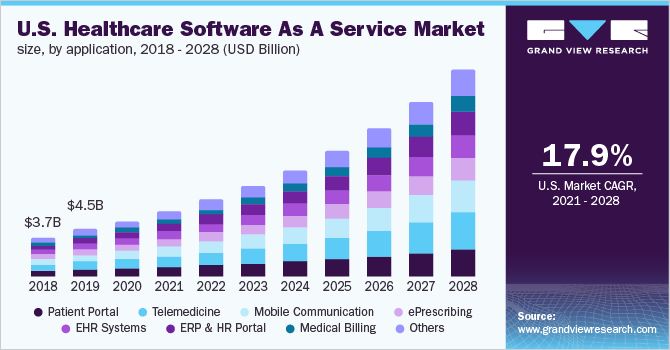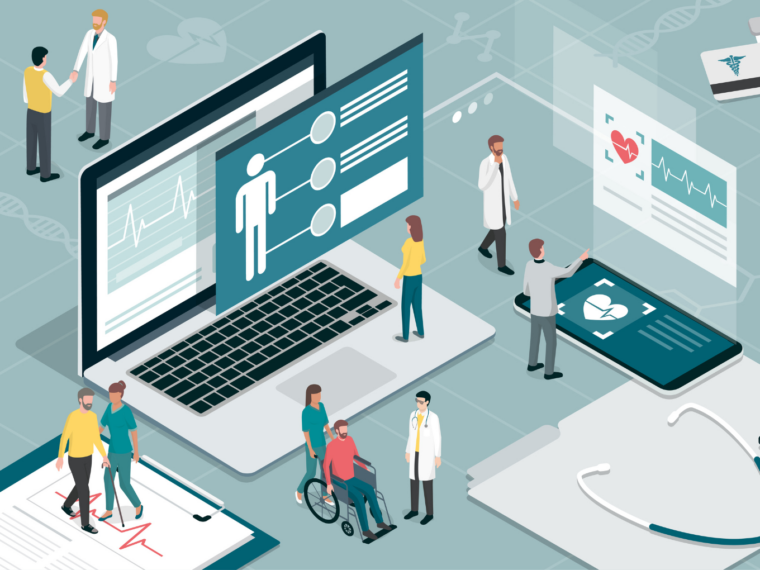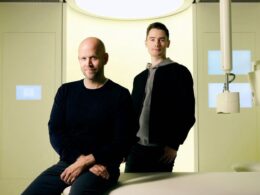This is a republication of the article “3 SaaS Trends That Will Revolutionise The Indian Heathtech Industry”, with the title above. The post is preceded by an Executive Summary.
institute for health transformation
Joaquim Cardoso MSc -Founder and CSO
January 20, 2023
KEY MESSAGE(S)
Healthcare software-as-a-service (SaaS) is on the verge of a market explosion and is becoming increasingly important due to its potential to : (1) provide enhanced patient experiences and (2) higher administrative efficiencies
- A new analysis from Grand View Research projects that the healthcare SaaS market is expected to grow at a CAGR of 19.5% and surpass $50 Bn by 2028
- People are becoming more aware of the viability, efficacy, and security of collecting and storing data in the cloud, as well as the numerous advantages provided by SaaS-based solutions
- SaaS can provide healthcare providers with better flexibility, higher ROI, a sharper competitive edge, and reduced software deployment costs.
- One of the main drivers of growth is the adoption of cloud computing in the healthcare industry.
The 3 key healthcare SaaS trends that will revamp the healthcare industry area in the area of:
- 1.Artificial Intelligence
- 2.Multiple Cloud Systems
- 3.Vertical SaaS
INFOGRAPHIC

DEEP DIVE

3 SaaS Trends That Will Revolutionise The Indian Heathtech Industry
Inc42
By Afsal Salu
14 Nov’22
Healthcare software-as-a-service (SaaS) is on the verge of a market explosion and is becoming increasingly important due to its potential to provide enhanced patient experiences and higher administrative efficiencies
A new analysis from Grand View Research projects that the healthcare SaaS market is expected to grow at a CAGR of 19.5% and surpass $50 Bn by 2028
People are becoming more aware of the viability, efficacy, and security of collecting and storing data in the cloud, as well as the numerous advantages provided by SaaS-based solutions
This ambitious yet completely realistic estimate is thought to be driven primarily by the growing adoption of cloud computing in the healthcare industry.
This may seem obvious given SaaS’s rising popularity across several industries but its applications in healthcare are particularly promising.
SaaS applications include both clinical (PACS, EHR, telehealth, etc.) and nonclinical (billing, supply chain, patient engagement) information systems.
What truly helps one comprehend the enormous market potential is the advantages SaaS can provide on the healthcare administration side.
For instance, SaaS can help immensely in managing healthcare IT costs by providing better flexibility, higher ROI, a sharper competitive edge, and reduced software deployment costs.
With new business models emerging in healthcare, providers are under constant pressure to manage profitability and SaaS can provide the necessary monetary advantage for the growth of the health businesses.
According to industry experts, SaaS will soon be essential to healthcare owing to its lower cost and scalability advantages.
SaaS solutions would be used by healthcare providers to increase revenue and improve internal processes.
HIPAA-compliant SaaS solutions help save deployment times by coordinating application delivery services across data centres all over the world.
According to industry experts, SaaS will soon be essential to healthcare owing to its lower cost and scalability advantages.
SaaS solutions would be used by healthcare providers to increase revenue and improve internal processes.

Let’s take a look at key healthcare SaaS trends that will revamp the healthcare industry:
- 1.Artificial Intelligence
- 2.Multiple Cloud Systems
- 3.Vertical SaaS
1.Artificial Intelligence
The market is set to be dominated by artificial intelligence (AI) because of its clever commercial applications.
SaaS platforms may develop self-learning and autonomy by integrating AI . Healthcare businesses frequently use AI-based solutions.
Many successful technology companies use AI to automate commercial procedures, increasing productivity and efficiency.
According to experts, 81% of businesses are already developing AI technology.
The effect of AI via machine learning (ML) and natural language processing (NLP) is revolutionising healthcare delivery.
This AI automation may help healthcare SaaS companies in a variety of ways.
It begins by addressing security flaws.
Finding possible risks is made simpler by having the capacity to recognise trends.
The best feature is that there is a self-recovery component that can assist in recovering important data.
Artificial intelligence is being used to streamline and automate the discharge process.
Health First, a Central Florida health system, has reduced the length of stay by 6 hours per patient by streamlining the discharge process with AI-powered analytics.
Health First, a Central Florida health system, has reduced the length of stay by 6 hours per patient by streamlining the discharge process with AI-powered analytics.
SaaS-based solutions can help organisations take the first steps towards harnessing the potential of AI across their administrative workflows, including the discharge process.
The NLP component can also assist in identifying patterns of human speech and voice control. Such software can aid in meeting patient requests and enhancing personalisation.
Another aspect is machine learning (ML), which businesses frequently apply to customer support applications.
Chatbots can be useful in certain situations.
According to a Crunchbase analysis, VCs have invested over $800 Mn in startups offering some form of a chatbot with health features.
Finally, AI-enabled SaaS enables high levels of overall responsiveness and the capacity for precise forecasts at extremely fast rates.

2.Multiple Cloud Systems
According to experts, there will be a 19.6% growth in the number of companies utilising cloud-based software.
New SaaS trends can help healthcare firms solve some of their most difficult problems by leveraging the power of multi-cloud solutions.
With a multi-cloud strategy, SaaS providers can run their applications in the same physical location as the customer.
This helps to reduce the high costs of inter-region bandwidth while also making things more cost-effective for healthcare providers.
Healthcare providers can also improve their capacity to store, handle, analyse, and safeguard crucial healthcare data by using several cloud providers.
There are several cloud service providers that are utilised for disaster recovery. Multicloud management can be deployed as SaaS-based subscriptions.

3.Vertical SaaS
Another interesting innovation that is gaining momentum in 2022 is vertical SaaS.
Horizontal SaaS can be used by any industry or sector, making it less specific to the needs and demands of that industry in terms of offering solutions.
Therefore, it has a wider approach as opposed to vertical SaaS which has a streamlined approach to an industry operation.
Healthcare is only one example of an area that vertical SaaS focuses on.
The development of supply chains or lighthouse customers might benefit from a vertical approach.
It becomes simpler to concentrate on specific issues and provides adaptable solutions that meet businesses’ demands while incorporating professional expertise.
The development of supply chains or lighthouse customers might benefit from a vertical approach.
With its tailored solutions, vertical SaaS will become a rising emphasis in the B2B healthcare technology market.
Examples of vertical SaaS include retail analytics software, contemporary logistics analytics, healthcare BI software, and patient engagement solutions.
Due to their customisation, the advantages of specialisation are more cost-effective.

Conclusion
Rising healthcare IT costs and data privacy are two key concerns when it comes to working in digitally transforming healthcare.
SaaS applications can play a critical role in addressing these concerns, especially in the healthcare sector.
People are becoming more aware of the viability, efficacy, and security of collecting and storing data in the cloud, as well as the numerous advantages provided by SaaS-based solutions.
This has begun a transformation in the use of technology more broadly within a controlled environment capable of adapting safely and serving humanity.
This has begun a transformation in the use of technology more broadly within a controlled environment capable of adapting safely and serving humanity.
Originally published at https://inc42.com on November 14, 2022.












